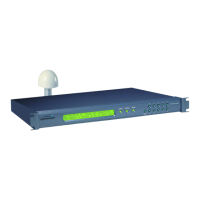MAINTENANCE/TROUBLESHOOTING
D. OPTION MOTHERBOARD (P/N 35007)
The option motherboard is used in order to expand the capabilities of the ExacTime. It
provides a computer buss command interface to option assemblies, if required, as well as
basic 1pps, 10MHz, 5MHz, 1MHz, IRIG B and other signals that may be required for option
expansion. The option slots (1-4) provide this information to optional plug-in assemblies
(see the ExacTime Configuration Guide for a list of the option assemblies available). For
this example the only option assemblies plugged in are the 1MHz and 5MHz sine wave
shapers. The sine wave shapers simply take the 1MHz or 5MHz TTL square wave signals
provided on the buss interface and provide a sine wave output to the rear panel BNC
connectors on the option motherboard. The option motherboard provides buffers before the
signals go the BNC connector so as to prevent and damage should the output be shorted for
any reason. Additional options could be added to this configuration as there are two
additional slots available for customer expansion. Should any of the option outputs fail it is
a simple matter to determine if the buffer has failed or the module assembly has failed by
swapping the modules. The sine wave shapers are interchangeable and can be plugged in to
any slot or from another unit. Power is provided to the assembly through a parallel cable
from the power supply.
E. X72 RUBIDIUM OSCILLATOR (OPTIONAL)
The internal oscillator can be an X72 Rubidium Oscillator. Its interface to the GPS Main
board (100015) is through a cable assembly attached to connector J23. The 10MHz
frequency output and the control voltage to adjust the frequency of the oscillator are via this
cable assembly. The control voltage is provided by a digital-to-analog converter on the main
assembly. It is used to discipline (control) the frequency output to the GPS reference.
5.3.4 MICROCOMPUTER PROGRAM THEORY OF OPERATION
The microprocessor clock provides a system where by the time as well as the frequencies generated
are “disciplined” i.e. phase locked to the GPS reference information. Looking at Figure 5-1 there are
two things that form the interface between the receiver and the clock. The first is an RS-422 I/O that
provides all of the operating commands, status, and GPS data to the clock. The second is an on-time
1pps reference pulse. Once the receiver has positioned the 1pps reference, and after it begins
tracking satellites, the difference (BIAS) between the 1pps reference and the real “on-time” 1pps is
measured. During the “Oscillator Stabilize” phase, the clock will take this BIAS information and
control the internal oscillator’s frequency to correct for any frequency offset. When the unit turns on
the LOCK LED, the current BIAS information is measured again and the difference (after much
filtering) is used to control the frequency of the internal oscillator.
Symmetricom Inc ET6xxx ExacTime GPS TC & FG (Rev C) 5-9

